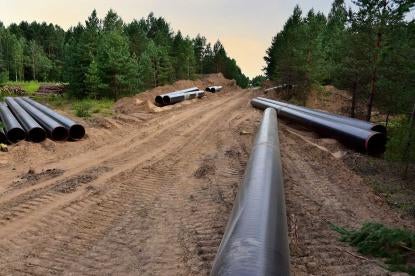Highlights
-
Both the Updated Certificate Policy Statement and the Interim GHG Mitigation Policy Statement take effect immediately and apply to all pending and new projects.
-
Updated Certificate Policy Statement
-
Demonstrating project “need” is now a threshold determination.
-
The existence of precedent agreements may not, in and of themselves, be sufficient evidence to establish project need.
-
Precedent agreements with affiliates are generally insufficient to demonstrate need.
-
Environmental impacts are now explicitly part of the Commission’s balancing test and includes a project’s impacts on climate change.
-
Impacts on environmental justice communities are also considered as part of the Commission’s balancing test for certificate applications.
-
-
GHG Mitigation Policy Statement
-
Establishes a “significance” threshold of 100,000 tpy of CO2e emissions for determining whether the Commission will prepare an EIS or EA.
-
Recognizes that the vast majority of natural gas projects will now require an EIS.
-
Project sponsors are encouraged to propose measures to mitigate climate change impacts.
-
Project sponsors may seek to recover GHG emissions mitigation costs through their rates.
-
Background
On February 18, 2022, the Federal Energy Regulatory Commission (FERC or Commission) published its long-awaited updates to its policy statement on the certification of new natural gas transportation facilities (Updated Certificate Policy Statement). The Commission issued notices of inquiry on April 19, 2018, and February 18, 2021, to explore whether it should revise the approach established by its prior certificate policy statement. The prior policy statement was issued in 1999 to set forth how the Commission would determine whether to approve applications to construct new natural gas pipeline projects under Section 7 of the Natural Gas Act. The Updated Certificate Policy Statement is the first time in over 20 years the Commission has revised its approach to approving new natural gas projects.
Concurrently with the Updated Certificate Policy Statement, the Commission published what it refers to as an interim policy statement on the consideration of greenhouse gas (GHG) emissions in natural gas infrastructure project reviews (Interim GHG Mitigation Policy Statement). The Commission is accepting comments on the Interim GHG Mitigation Policy Statement until April 4, 2022. However, both the Updated Certificate Policy Statement and the Interim GHG Mitigation Policy Statement take effect immediately and apply to all pending and new projects. The Commission stated that applicants with pending projects will have the opportunity to supplement their proposals to explain how they are consistent with the new policies and interested parties will have an opportunity to respond.
Updated Certificate Policy Statement
Although the Commission’s Updated Certificate Policy Statement employs the familiar balancing test—weighing the benefits of a project against its adverse impacts—to determine whether a project is required by the public convenience and necessity, the Commission has significantly altered the factors that it will consider as part of the balancing test.
Demonstrated “Need” Is Now a “Threshold”
The first major change is the formulation of a new threshold determination of a project’s “need.” For this threshold test, the Commission states that it will consider all relevant factors bearing on the need for a project. To aid in this determination, the Commission encourages applicants to provide specific information about the end-use of the gas transported by the project, why the project is needed to serve that use, and the expected utilization rate of the project. The Commission also directs applicants to work with prospective shippers to obtain information about the end-use of the gas and stated that the absence of this information may prevent an applicant from meeting its burden to demonstrate project need.
Going forward, the Commission explains, although precedent agreements remain important evidence of need the existence of precedent agreements may not, in and of themselves, be sufficient evidence to establish project need. The Commission now will also look at other evidence beyond the agreements to assess project need. Additionally, the Commission will analyze the facts and circumstances surrounding the precedent agreements, including the results of any open season, and whether the precedent agreement(s) were entered into in response to local distribution company or electric generator requests for proposals. The Updated Certificate Policy Statement also states that the Commission will generally find precedent agreements with affiliates to be insufficient to demonstrate need, if not supported by additional evidence.
The Updated Certificate Policy Statement categorizes various types of projects and outlines relevant factors or evidence the Commission will consider when determining whether need for a project exists. For a “market-driven” project that is responding to increased natural gas demand, the evidence relating to the need for the project could include market study projections, analyses from the U.S. Energy Information Administration, or an assessment of available transportation capacity. For projects serving individual shippers, the Commission will consider load growth profiles, gas supply portfolios, and any advanced approval of contracts by state regulatory bodies. For producer “push” projects, the Commission will consider evidence demonstrating consumer benefits including lower natural gas prices due to increased competition, and regional projections for both gas supply and market growth as well as pipeline-specific studies in these areas. Finally, for reliability or efficiency projects, which do not necessarily increase pipeline capacity, the Commission will consider how proposed facilities provide expected system benefits such as reduced operating costs, improved pipeline integrity, or reduced natural gas leaks. The Commission will also consider how a project avoids adverse impacts or satisfies any changing state or federal government regulations.
Finally, in considering a proposed project’s need, the Commission will consider record evidence of alternatives to the proposed project. For example, FERC will consider information indicating that other suppliers would be able to meet some or all of the needs to be served by the proposed project on a timely, competitive basis or whether other factors may eliminate or curtail such needs.
Formulating a New Balancing Test
Once the Commission has determined there is need for a project, it will weigh this need against any adverse effects of the project. The Commission states that it will balance the following factors:
-
Impacts on existing customers. The Commission will consider whether existing customers of the pipeline applicant may be adversely affected, such as if a proposed project causes an increase in rates or a degradation in service. The Commission also retains from the 1999 Certificate Policy Statement the “no-subsidy” requirement that a pipeline must be prepared to move forward with a project without relying on subsidies from existing customers.
-
Captive customers of existing pipelines. The Commission will consider whether captive customers of existing pipelines may be affected by new projects due to the loss of market share and any resulting unsubscribed capacity investment. To the extent that a proposed project is designed to substantially serve demand already being met on existing pipelines, the Commission may see this as an indication of potential overbuilding. In such instances, the Commission will also consider whether the proposed project would offer certain advantages (e.g., providing lower costs to consumers or enhancing system reliability).
-
Environmental issues. For the first time, the Commission is explicitly including environmental impacts as part of its balancing test. The Commission states it will balance all impacts, including economic and environmental impacts, together in its public interest determinations under the Natural Gas Act (NGA). Further, the Commission will consider environmental impacts and potential mitigation of impacts not only during its review under the National Environmental Policy Act (NEPA), but also as part of its determination under the NGA of whether the project is in the public interest. The Commission will assess mitigation consistent with its concurrently issued Interim GHG Mitigation Policy Statement, as detailed below. The Commission states that if proposed mitigation is not sufficient to establish that the project is in the public interest, the Commission will attach conditions to require additional mitigation, or deny the application. Significantly, the Commission states that it intends to fully consider a project’s impacts on climate change, as well as other environmental impacts.
-
Landowner and community interests. The Commission states that landowner considerations will be more expansive, with the Commission assessing a wider range of landowner impacts than assessed previously. The Commission will consider the steps a pipeline applicant has already taken to acquire lands through respectful and good faith negotiation. The Commission states that it expects pipelines to take steps to minimize the future need to use eminent domain and will look “unfavorably” on applicants that do not work proactively with landowners to address concerns.
-
Environmental justice. The Commission states that it will seriously evaluate impacts on environmental justice (EJ) communities and, for the first time, incorporate them into the balancing test for certificate applications. The Commission’s EJ analysis will consider pre-existing conditions, including air pollution, heat vulnerability, and effects of pre-existing infrastructure (e.g., bus depots, highways, and waste facilities), as well as mitigation measures tailored to reduce impacts on EJ communities. The Commission anticipates that the recently established Office of Public Participation will play an important role in ensuring EJ communities are able to participate meaningfully in Commission proceedings. Finally, the Commission states that it will engage with Native American Tribal governments.
The Commission states that the balancing test in the Updated Certificate Policy Statement is flexible and makes clear that a proposal may be denied solely on the magnitude of a particular adverse impact to any one of the interests described above. The Commission further states that it will consider whether the magnitude of any impact can be mitigated consistent with its Interim GHG Mitigation Policy Statement. Finally, the Commission states that it recognizes that there may still be proposals that have significant adverse impacts but are still found to be in the public interest.
Interim GHG Mitigation Policy Statement
Issued concurrently with the Updated Certificate Policy Statement, the Interim GHG Mitigation Policy Statement proposes several major changes to Commission policy that will bear significant consequences for project applicants, particularly when it comes to conducting environmental review of GHGs under NEPA and mitigating GHGs as a condition to project approval.
The first major policy change is the establishment of a “significance” threshold of 100,000 metric tons per year (tpy) of CO2 equivalent for determining whether the Commission will prepare an environmental impact statement (EIS) or a smaller environmental assessment (EA). The Interim GHG Mitigation Policy Statement directs Commission staff to apply the 100% utilization or “full burn” rate for natural gas delivered by a proposed project and to prepare an EIS if the estimated emissions could exceed the 100,000 tpy threshold. The Commission states that this threshold will generally be met by projects transporting an average of 5,200 dekatherms per day and projects involving the operation of one or more compressor stations or liquefied natural gas (LNG) facilities. This would require the vast majority of natural gas projects to have an EIS.
Additionally, the Interim GHG Mitigation Policy Statement proposes a framework to assess whether GHGs attributable to a proposed project have an impact on climate change, another first for the Commission. In determining potential impacts on climate change, the Commission will not use a full burn estimate, but will accept evidence of projected utilization rate and evidence of factors expected to reduce or offset the estimated emissions that result directly from the project, or indirectly, for instance, as a result of downstream emissions caused by the project. With respect to indirect GHG emissions, the Commission states that in most cases downstream emissions (from end-use combustion) will be considered indirect impacts and thus included in its emissions analysis, while it will determine whether to consider upstream emissions (from production) on a case-by-case basis. However, with respect to LNG export facilities that are authorized under section 3 of the NGA, the Commission explains that the facilities are not the legally relevant cause of upstream or downstream GHG emissions under NEPA, and thus will be excluded from its analysis.
Finally, project sponsors are encouraged to propose measures to mitigate climate change impacts. The Commission states that its priority is for a project’s direct GHG emissions to be mitigated “to the greatest extent possible.” The Commission states that it will consider mitigation measures proposed by the project sponsor on a case-by-case basis when balancing the need for a project against its adverse environmental impacts and may impose additional mitigation as a condition, should the Commission deem a project’s proposed mitigation inadequate to support the public interest determination. The Commission’s primary concern is mitigating a project’s direct emissions, but encourages project sponsors to propose mitigation of indirect upstream and downstream emissions as well. The Interim GHG Mitigation Policy Statement does not specify a particular mechanism of mitigation a project sponsor may be required to implement, but provides option including market-based mitigation, incorporating renewable energy, carbon capture and storage, direct air CO2 capture, planting trees, and restoring wetlands. The Commission also stated that it would consider proposals to reduce the GHG emissions from project sponsors’ existing facilities, including those with no direct connection to the proposed project. The Commission states that pipelines may seek to recover GHG emissions mitigation costs through their rates, similarly to how they seek to recover other costs associated with constructing and operating a project.
Implications
The Commission’s Updated Certificate Policy Statement and Interim GHG Mitigation Policy Statement represent profound changes to Commission policy, which will likely reverberate through the natural gas pipeline industry for years. While the policy statements lay out a plethora of factors the Commission will consider in determining whether projects are in the public interest, it does not actually spell out the requirements for meeting its new tests. It is unclear what level of evidence will be required to demonstrate a project is “needed,” or how it will balance this need against the project’s adverse effects. It is also unclear what level or form of GHG mitigation measures the Commission will accept. Commissioner Danly characterized this in his pointed dissent as a “tyranny of vagueness.”
Both policy statements are effective immediately and the Commission intends to apply them to both pending and new projects. Many projects pending before the Commission have been delayed, undergoing multiple layers of environmental review, including the preparation of both an EA and an EIS. Those applicants will now have to supplement the record to demonstrate consistency with the Commission’s new policy statements, offering novel mitigation measures that even the Commission itself notes may be “impractical.” This, no doubt, will cause additional delays to needed natural gas projects that have already been burdened by a year of policy changes prior to the publication of the Commission’s policy statements.






 i
i

